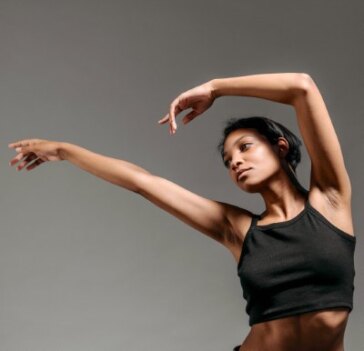
In this series of 4 blog posts, I will share ideas inspired by MAEIA assessments for arts curriculum integration across K-12 school subjects and grade levels. These arts integration ideas are intended to foster interconnection across school subject areas that could lead to longer-term interdisciplinary collaborations between certified arts educators and certified non-arts educators in schools across the State of Michigan. Student learning deepens across subject areas with the insight cross-disciplinary teaching and learning can provide. Check out the English Language Arts and Music blog post.
___________________________________________________________________________________________________________
 Arts Subject Area: Dance
Arts Subject Area: Dance
Grade Level: High School
MAEIA Assessment: D.T401: Variation of a Theme Using Jazz Combinations
National Core Arts Standards (NCAS) Anchor Standard: DA: Cr2–Organize and develop artistic ideas and work.
Non-Arts Subject Area to Integrate: Life Science
Life Science Content Standard: HS-LS2-8 Evaluate the evidence for the role of group behavior on individual and species’ chances to survive and reproduce.
___________________________________________________________________________________________________________
The life science content standard (above) asks students to evaluate evidence for the role of group behavior on individual and species’ chances to survive and reproduce. Applying the choreographic concept of theme and variation to this standard allows students in the dance studio to examine both individual and group work while addressing both dance and life science standards. Since students will be individually adapting a movement phrase to create a variation on the original choreography, with a small adaptation, students can also think through creating a variation that shows how group behavior impacts a species survival and reproduction.
To begin, the dance teacher creates a phrase of jazz choreography that has the theme of survival, perhaps even inspired by a specific species or biome that the students are studying in their life science course. After students have learned the initial survival phrase, they are instructed to place themselves randomly around the studio, facing any direction at all. Because of the random placement of students, pathways and personal space will overlap, compelling students to respond to encounters with their peers, thus informing their choices in variation choreography. This is where movement choices such as retrograde, ornamentation, repetition, and fragmentation can come into play. Since the MAEIA assessment is explicit about not using music, the teacher could use a metronome to provide a unifying tempo for students to explore altering the choreography independently but at the same pace.
Based on the original movement phrase with the theme of survival, students are instructed to create two unique choreographic variations:
- The danger of heightened isolation focusing on heightening isolation and vulnerability to show the danger this can create for individuals of a species.
- The safety in numbers variation highlighting choreographic choices that emphasize group unity and collective protection.
Given the complexity of interdisciplinary learning, it would be helpful to allow the students multiple opportunities to discuss their ideas and sufficient time to think/rehearse/move through this work before they participate in the final assessment. Some exploratory questions might include:
- Which natural environment could we collectively imagine for this choreography about survival, isolation, and safety in numbers?
- How might the species you’re bringing to life behave in isolation versus when it is with a group of its own species? How might you show that behavior with your body?
- How do you maintain awareness of your peers while choreographing your variations?
- What science concepts inspire or impel you to make certain choreographic changes?
- What does this work tell you about the element of space in dance?
- How might you adapt your choreography when it puts you on a collision course with other dancers in the room?
As a way of demonstrating independent choreographic skill and collective understanding of the life science standard they are learning, students can ultimately perform the trio of jazz combinations: survival, danger of heightened isolation and safety in numbers as their assessment in both subjects.
When approaching teaching through arts integration, it is important not to lose the rigor of teaching towards one subject area standard over another. There needs to be a balance between the content areas and a clear understanding of how each of the teachers involved (in this case, the dance teacher and the life sciences teacher) supports student learning in both disciplines. A dance educator can show the life sciences teacher how theme and variations choreography can communicate details about relationships and their development over time. In response, the life sciences teacher can describe the model, experiment, exemplar, or allegory they typically use to teach the role of group behavior in the survival and reproduction of an individual animal or entire species. Together, the life science and dance teachers can combine these ideas as a jumping-off point to practice arts-integrated teaching and learning.
In this survival choreography example, students have the opportunity to think about content with both their minds and bodies. Their success in choreographing two variations on a theme hinges on their understanding of the life sciences concepts of group behavior and survival, as well as on their understanding of the choreographic approach of theme and variation. Students are creating the choreography on their own in this learning space, but the choreography they create is grounded in inevitable interactions with peers while they create it. They must contend with encountering their classmates to successfully create each variation and demonstrate understanding of the role of group interactions in species survival.
When students learn through multiple modalities like applying dance and choreographic concepts to life sciences content and bringing a life sciences lens to how they create a jazz variation, it creates more opportunities for deep and enduring learning that can last well beyond the end of the school year.
___________________________________________________________________________________________________________
 Karenanna Boyle Creps, PhD, is an Assistant Professor of Teacher Education at Michigan State University. She is the Subject Area Leader of Arts Integration and the Licensure Area Leader for K-12 Visual Arts Education. Her research interests are in arts education, experiential learning, intercultural education abroad, the ethics of education research, and arts-based research methodologies.
Karenanna Boyle Creps, PhD, is an Assistant Professor of Teacher Education at Michigan State University. She is the Subject Area Leader of Arts Integration and the Licensure Area Leader for K-12 Visual Arts Education. Her research interests are in arts education, experiential learning, intercultural education abroad, the ethics of education research, and arts-based research methodologies.
Images provided by Santa Monica College and Slide Player.
Click here for a Printer friendly version of this article.
Leave a Reply
You must be logged in to post a comment. Don't have an account? Register Here.